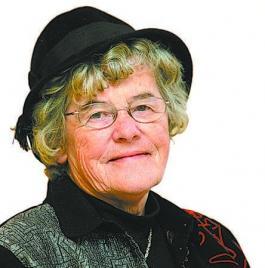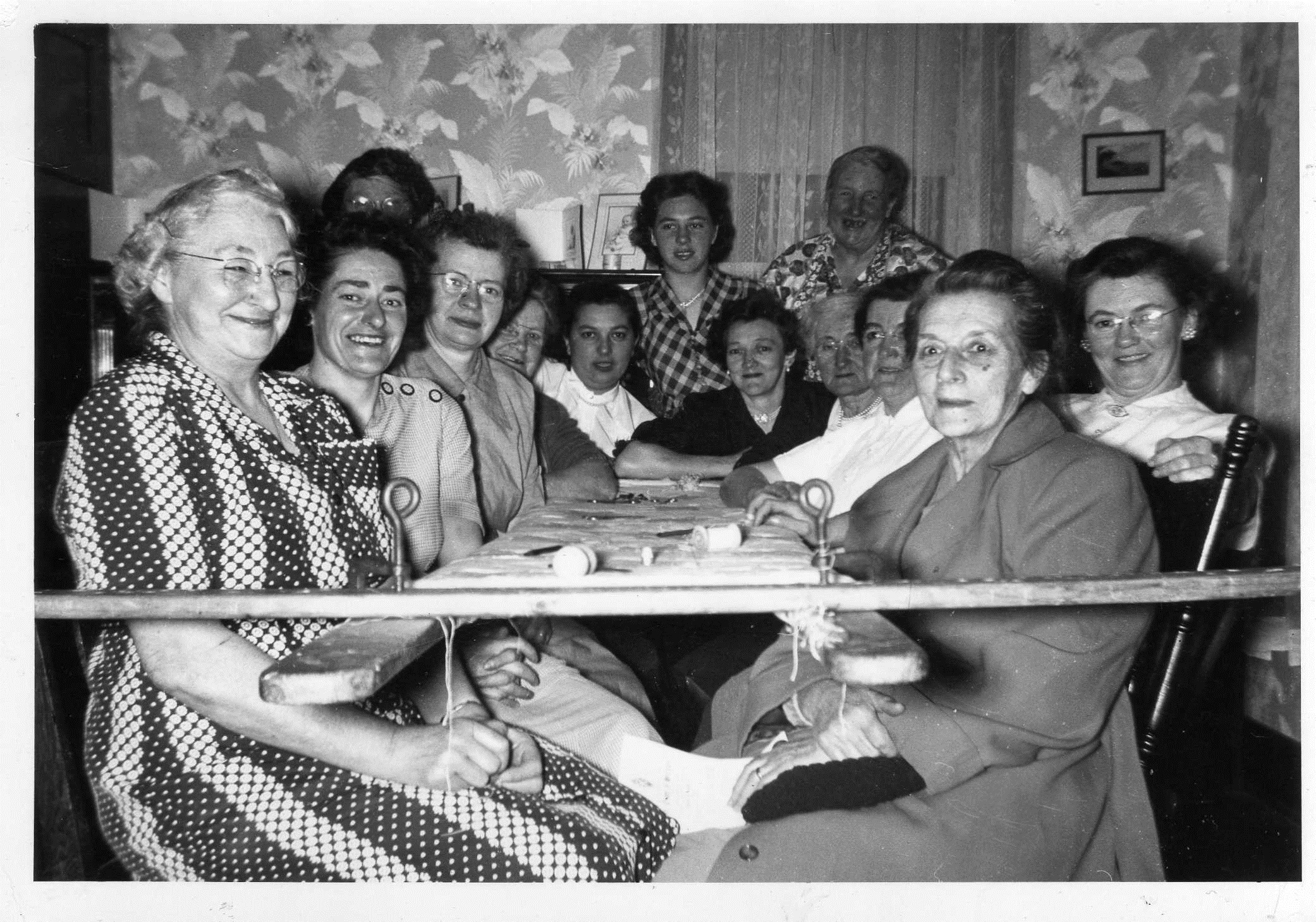
Ruby M. Cusack
The Base Gagetown Community History Association

THE SEWING CIRCLE Picture courtesy of Allison Inch
The picture of the Sewing Circle was taken at the United Church Manse in New Jerusalem, circa 1953. It was the last quilting party held at the Manse. Gathering together to quilt was the way it was done – the quilt would be put on the wooden frame and the ladies would gather to quilt it.
Seated around the quilt starting left: Alma Johnson (Mrs. James), Edith Kennedy (Mrs. Clifford), Lois MaGee (Mrs. Harry), Margaret Thom (Mrs. Andrew), Mildred Russell (Mrs. William), Ruth Fitzsimmons (Mrs. Robert), Lillie Machum, Nita Johnson (Mrs. Ralph), Elsie Inch (Mrs. Ronald), Annie Elder (Mrs. John). Standing in back: Gertrude Golding (Mrs. Clifford), Geraldine Harrison (Mrs. Ken), and Minnie Golding (Mrs. George).
**********************
For several days Mum had suffered from sore itchy swollen eyes and felt terrible.
Dad didn’t help much with his comments, such as, “You got into this mess with weeds once before so you knew better than go to the garden to pick the cucumbers” or “The kids could have gone to the garden for you”.
I kept quiet as I felt very guilty.
The day Mum came in contact with the poisonous weed she asked me to get her a pail of small cucumbers. But, I was in a hurry to go to the hay mow to play with the little kittens. I had replied, “I’ll do it later”.
Very quickly the word spread through the family that she needed help with the pickling. On Saturday afternoon company arrived, not to visit, but to work. They even brought a large potato scallop, a corn scallop, a Washington pie, fresh doughnuts and lots more.
Gramp came prepared with several pails and baskets. The men headed to the garden with the wheelbarrow to get the cucumbers and green tomatoes while the ladies brought in large enamel pots along with peeling knives, spices, vinegar, sugar and salt.
Glen returned in no time from the garden with four pails of cucumbers in the wheelbarrow. As usual, he made everybody laugh as he pretended to be driving a truck with lots of sound effects.
Cliff and I sorted the cukes by size. The big ones were for Lady Ashburnham relish and the small ones for sweet pickles.
When I saw the onions, I hoped I would not be asked to help peel them as this task made lots of tears roll down my cheeks.
Extra chairs were brought to the outside kitchen. Everyone set to work, either peeling or slicing.
Aunt Sadie was in charge of getting the ingredients prepared and putting the cukes and green tomatoes to soak until it was time to cook them.
Greta went down the stone cellar steps to find the bottles which were recycled year after year as every bottle that came into the house was saved. She washed them, then turned them upside down in a cookie pan to sterilize them in the oven.
Last evening, Dad had tried to prepare a batch of pickles. He put them to soak in salt and water. Today the brine was drained off and the pickles were put on the stove to cook.
Some small beets were topped and washed and were now cooking.
Looking through the spice cupboard the ladies found only a little bit of cloves. Neither could they find on any shelf the parowax used to seal the bottles. Fortunately Gram had extra at her house.
The aroma of pickles and spices filled the air which really turned the key on to the talking mode as everyone had a story to tell about the past or news of the present.
Mum had been resting but came out to see how things were progressing. Her first words were, “All the talking and folks gathered together made me think there was a meeting of a Sewing Circle going on here but by the smell that drifted to the bedroom, it must be a Pickling Bee.”
Gathering to help one another was a part of life for the expropriated families who resided in the communities now occupied by Canadian Forces Base Gagetown.
Loving Home is easy. Leaving Home behind is not easy. It was a sad day for these people knowing their homes would be torn down and they would never be able to go back.
The Base Gagetown Community History Association Inc. was officially organized in July, 1998 to collect the history of over 20 communities and the genealogy of the 750 families that resided prior to 1953 in the 500 sq. mile area in Queens and Sunbury Counties of South-Western New Brunswick.
Their website at http://www.bgcha.ca has family histories, list of students, short biographies of teachers and others as well as interesting stories about the people and detailed information on these places of the heart.
The purpose of this website is for the sharing of knowledge relating to the former training area families and communities.
I found this informative article on the site which tells of the empathy A. J. Brooks, Q.C. Member of Parliament for Royal Constituency, had for these people as he spoke in the House of Commons in 1952, “. . that it had come as a great shock to the people residing in western Queens County to read in the newspapers that their homes were to be taken from them to be used as a military camp. Not only do they have to leave their homes, but also their farms, their communities, their churches, schools, friends, societies and the cemeteries. They are splendid people whose ancestors have lived in that section for four or five generations.... There are no finer people in New Brunswick than those in the CFB Gagetown area. They had good farm lands and some of the finest dairy farms in New Brunswick. Then, too, they had distinguished themselves in the last war”.
Having been a School Marm, the School Attendance Records, Pictures of the Schools, Memories of a North Clones School Teacher and brief Biographies of Teachers appealed to me. For example, William Henry Allingham was aged 49 years in 1901, and was married to Mary Jane Hamilton, and had 7 children living at home. He taught at the South Clones School for the term ending December 1885 and the following term in 1886.
The Oral History Interviews are extremely interesting and give the impression of one sitting at the kitchen table listening in on a conversation.
One goes back to yesteryear while watching a Slide Show of the many homes that were expropriated.
Obituaries that have been submitted to the BGCHA Mail List are helpful to family researchers.
Photos and clippings that were thrown in the garbage when one house was being cleaned out were rescued and scanned.
Memories live forever and have been preserved for future generations through the many village histories, maps showing location of families, newspaper clippings about the Expropriation, the many photos and much more on the BGCHA website at http://www.bgcha.ca. All of this gives us a look through the window into life in 1953 and before, of an area loved by many that no longer exists.
By the way, the Base Gagetown Community History Association will be having a display booth at the Queens County Fair in Gagetown on September 14 to 17. The theme will be the 1950's.
Visit Ruby's Bookshelf
|
New and Used Genealogical and Historical books of New Brunswick for sale. |
Back to Home of rubycusack dot com